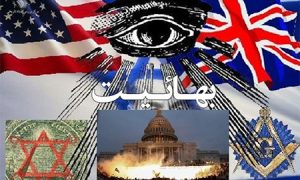The current deviant cult of Bahaism must be called as the American one organizationally. One of the main reasons for proselytizer Abbas Effendi’s photo is this issue.
In the history and even in the Baha’i books, there are many documents indicating the cooperation and bond between the Baha’is and governmental and security officials of America which are as
follows:
۱) The relationship with the American advisors:
- a) Entertaining the American advisors in Iran by the Baha’is such as entertaining Robert Lee Kevlik by Houshmand Fath A’zam (the next member of the universal house of justice in Israel) during 1320s S.H.[1]
- b) the presence of Edward Schlesinger (the American Baha’i Jewish proselytizer and the member of the board of military advisors of that country in electronic industries of Iran during Pahlavi era) in the proselytizing classes of the Baha’is of Iran.
۲) The bond with the American magazine of the faith news of the Baha’i organ reports in 1351 S.H. entitled “The activities of the United States of America” that a matter will be a published in a book which is being published by the army of the united states of America about the Baha’i faith. The mentioned magazine continued: “This is a great development “because it gives correct information for the readers about the Baha’i faith.[2] This magazine writes in autumn 1340 S.H. entitled a Baha’i advisor: “Meriland periodical has published an article about the development of the programs of Meriland university branch in Seoul city and Mr. William. H. Maxwell has been introduced as one of the four main people in charge of the branch that Mr. Maxwell is a Baha’i proselytizer and the cultural advisor of the eighth army of America”[۳]
۳) The bond with the American state official: In a meeting of the Baha’i youth in America which was held during the days of the universal conference of the Baha’is in America (Saint Louis – Missory Out 1974 A.D.), the governor of Kansas State also sent a congratulating telegraph and mentioned: I hope the next conference of the Baha’is of America would be held in Kansas[4] along with the congratulating telegraph to the Baha’i national assemblies of various parts of the world (including Iran).
۴) The bond with the American embassy and CIA: The faith news of the year 1351 S.H. writes entitled “Chad”: “Miss. Yazdi reports about her trip to Chad that she had traveled for a suggested 13-day period of time. Exactly before the departure, she visited the American ambassador and the head of peace group in Chad. Both were aware of the issue and the second person gave brief information about the customs, traditions and beliefs of villagers which were beneficial for me. I remember that Shogi Effendi advised the immigrants to be familiar with habits and customs of their migratory regions in order to adapt the proselytizing method with the local circumstances. I observed its wisdom in near future when we helped a group in the village to vote to the village guardians. Women avoided to vote. They were They to illiterate. We commissioned some men to write their votes…”
۵) The bond with the white house: In this regard, the presence of famous Baha’is such as Firouz Kazem Zadeh as the culture advisor of the white house and supporting this cult by the American presidents like Johnson and Reagan can be mentioned during the years before and after the Islamic Revolution. The magazine of the faith news mentions (Mehr, 1346 S.H., No. 7, pp. 286- 287) the congratulating message of Johnson to the American Baha’i assembly for the occasion of centennial anniversary of the establishment of Bahaism.
[۱] Ahang-e-Badi’a, 2nd year, (1326), NO. 15 & 16, p. 165.
[۲] The faith news, 1351 S.H., No.5, p.151.
[۳] Ibid, 40th year, Mehr, 1340 S.H., No.7, p.390.
[۴] Ibid, 1353 S.H., No.11, p. 314 and 138






